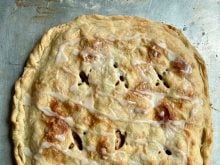Jeanine LaSalle of Sceptre, Sask., wants to compile a cookbook celebrating the best of beef and ranch recipes. She would like the book to capture the feeling of the times and how people are coping with BSE.
She is looking for your favourite recipes, as well as a history about your ranch or farm. Any thoughts that you have about the current farming situation in the form of original cartoons, stories or poems would also be welcomed. Profits from the sale of the cookbook will be directed to an agricultural grassroots organization that will use it for scholarships. Forward your recipes, histories, stories, poems and ideas to: Jeanine LaSalle, Box 71, Sceptre, Sask., S0N 2H0, 306-623-4663 or e-mail jeanine_russell@yahoo.ca.
Read Also

From farmer to award-winning distiller
Pivot Spirits showcases transition from farmer to distiller with provincial award-winning results in Alberta for Lars Hirch
Canning citron
Dear TEAM: Do you have any recipes for canning citron as a fruit, jam or marmalade? – L.S., Calgary.
Dear L.S.: There are few recipes for using citron. I did find one for citron preserves, in an Agriculture Canada publication, Jams, jellies and Other Preserves, printed in 1983. I do not have any citron to test these recipes but I believe the source is credible.
Citron is a round, green and white striped melon, about half the size of a watermelon.
Citron preserves
33 cups citron, peeled, cut in 3/4 inch (1.5 cm) cubes about 8.25 L
2 tablespoons salt 30 mL
51/2 quarts water 5.5 L
11 cups sugar 2.75 L
2 tablespoons lemon rind 30 mL
1 cup lemon juice 250 mL
1/3 cup chopped, candied 75 mL
or preserved ginger
Cover citron with salt and water. Let stand overnight. Drain thoroughly. Add remaining ingredients to citron. Bring slowly to boil, adding water if necessary, to prevent scorching. Cook until syrup is clear and citron is translucent, about 20 minutes.
Ladle fruit into a clean hot one cup (250 mL) jar to within 1/4 inch (0.5 cm) of top rim (headspace). Using nonmetallic utensil, remove air bubbles. Wipe jar rim removing any stickiness. Centre snap lid on jar; apply screw band securely and firmly until resistance is met fingertip tight. Do not overtighten. Repeat for remaining fruit.
Cover canner, bring water to a boil. At altitudes up to 1,000 feet (305 m), boil filled jars 10 minutes. When processing time is complete, turn heat off and remove canner lid. When boil subsides – bubbles no longer rise to surface (three to five minutes) – remove jars without tilting. Cool jars upright, undisturbed 24 hours. Do not retighten screw bands.
After cooling, check jar seals. Sealed lids curve downward and do not move when pressed. Remove screw bands; wipe and dry bands and jars. Store screw bands separately or replace loosely on jars, as desired. Label and store jars in a cool, dark place.
Makes about 16 jars (250 mL).
Altitude difference
At altitudes higher than 1,000 feet (305 metres) process time as indicated in chart.
Altitude increase
Feet Metres Processing time
1,001-3,000 306-915 five minutes
3,001-6,000 916-1,830 10 minutes
6,001-8,000 1,831-2,440 15 minutes
8,001-10,000 2,441-3,050 20 minutes
I was also able to find some information about citron on the Seeds of Diversity website. Members are able to obtain samples of more than 1,500 varieties of seeds and plants offered by other members in exchange for return postage.
If you are looking for hard-to-find seeds, this would be a good place to start. A regular membership is $25. Seeds of Diversity Canada, P.O. Box 36, Station Q, Toronto, Ont., M4T 2L7, or visit www.seeds.ca/en.htm.
The following is some of the historical information on the website about citron.
“Citron jam is hard to beat, and it is doubtful if any other plant will give an equal weight of preserving fruit on the ground occupied. For successful cultivation follow the directions given for cucumber.
For citron jam, cut well ripened fruit in cubes about one x one inch (2.5 x 2.5 cm); pick out the seeds; cover with water and boil until tender.
Drain off water, weigh fruit and add one pound (500 grams) of sugar to each pound (500 g) of fruit (no more water), and to each citron add 1/4 pound (125 g) preserved ginger and one lemon cut up fine. Boil until syrup is thick.”
I would suggest that you process this as above for the citron preserves.
Changes to home canning
As we prepare for the home canning season it is important to follow updated advice. Over the years, our understanding of food safety has grown. At the same time, new products, technologies and agricultural crop varieties have been developed and new strains of micro-organisms have evolved.
For these reasons, it is important to follow current guidelines for home canning instead of old recipes. While they might be family favourites, older recipes may not have been properly tested to achieve adequate heat processing times and temperatures for food safety and quality.
The Bernardin company, which makes snap lids and canning jars, has done extensive research and testing of home canning practices. The following are some of its recent recommendations.
Processing times
The processing times for all home canned high acid foods including soft spreads jam, jelly, marmalade, preserves, conserves, butters should be a minimum 10 minutes.
Bernardin researchers have found that the vacuum is enhanced so the seals are more reliable and durable with a 10 minute processing time.
As the interest in reduced sugar spreads increases, the extended processing time is required to destroy micro-organisms that would no longer be held in check by a high sugar level. Testing showed no deterioration in quality, gel or colour due to the longer processing time.
The longer processing time also simplifies general recipe preparation in that sterilization of jars before filling is no longer required or recommended. Bernardin home canning recipes specify that clean mason jars be heated to a simmer in a boiling water canner. These jars are then filled and closed, and then returned to the canner. The canner lid is placed on the boiling water canner, the water is brought to a full rolling boil and counting of the recommended processing time begins. The full sterilization of the container, closure and product takes place during this recommended heat processing time, all in one step.
The practice of heating mason jars in an oven, a procedure that can result in jar breakage, is not recommend or needed. Also, the practice of hot filling, which skips the heat processing step and frequently results in seal failure, is not recommended.
Boiling lids before putting on jars is no longer required. This recommendation has been changed to “heat snap lids in hot water, not boiling.” The lids must be hot when placed on hot jars of hot food, whereas screw bands should be room temperature. Tighten screw bands firmly until resistance is met. Don’t overtighten. Heat processing is still a necessity. Screw bands require no preparation and are much easier to handle if left at room temperature.
New guide to home preserving
The new Bernardin Guide to Home Preserving (August 2003) makes these changes in all recipes. The guide has information on home canning, freezing, dehydration and crafts as well as recipes. This preserving guide can be purchased from the Bernardin website at www.homecanning.com/can or from any store where canning supplies are sold. For canning questions, call 888-430-4231, fax 416-239-4424 or e-mail info.ca@homecanning.com.
Cookies from cake
Dear TEAM: Someone told me you had a recipe for cookies made out of cake mix. I’d sure love to see it in print again as I must have missed it the first time it was in the paper. – A.S, Isabella, Man.
Dear A.S.: These cookies are called Oreo cookies. They are delicious. During cooking they do expand, so it is better to make the balls about the size of marbles.
2 mixes chocolate or 510 g devil’s food cake
2/3 cup canola oil 150 mL
4 eggs
Icing:
1/2 cup softened margarine 125 mL
3/4 cup icing sugar 175 mL
1 package cream cheese, 250 g at room temperature
2 teaspoons vanilla 10 mL
Cake: In a large bowl, combine the cake mixes, oil and eggs. Stir with a wooden spoon. Roll dough into balls and place on a cookie sheet. Do not flatten. Bake at 350 F (180 C) for 10-12 minutes. Cool on rack.
Icing: Beat margarine, icing sugar, cream cheese and vanilla until smooth. Put icing between two cookies and sandwich together.
Flax buns
A reader shared her recipe for flax buns made in a bread machine.
11/4 cups warm milk 310 mL
1 egg, beaten
1/4 cup white or brown sugar 60 mL
3/4 teaspoon salt 3 mL
3 cups bread flour 750 mL
3/4 cup flax meal 175 mL
11/2 tablespoons bread machine 22 mL
yeast
Place in above order in a bread machine and select the dough setting.
When cycle is completed, turn dough onto a lightly floured board and punch down. Divide dough in half. Roll each portion 3/4 inch (two cm) thick and cut in with 21/2 inch (five cm) cutter. Place on lightly greased sheets.
Brush top with melted margarine or butter. Cover and let rise about one hour. Bake at 350 F (180 C) for 10-12 minutes. – E.A., Yellow Grass, Sask.
Trans-fat free recipe
M.B. of Winnipeg, Man. requested more recipes for breads without trans fats. This flax bun recipe does not have trans fats except if you brush the tops with melted hard margarine. The flax buns have the added advantage of containing omega 3, 6 and 8 fatty acids.
Betty Ann Deobald is a home economist from Rosetown, Sask., and one of four columnists comprising Team Resources. Send correspondence in care of this newspaper, Box 2500, Saskatoon, Sask., S7K 2C4 or contact them at team@producer.com.














